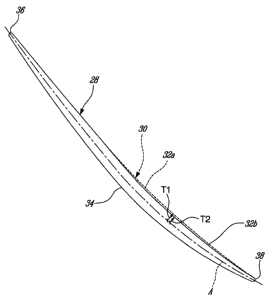Some of the information on this Web page has been provided by external sources. The Government of Canada is not responsible for the accuracy, reliability or currency of the information supplied by external sources. Users wishing to rely upon this information should consult directly with the source of the information. Content provided by external sources is not subject to official languages, privacy and accessibility requirements.
Any discrepancies in the text and image of the Claims and Abstract are due to differing posting times. Text of the Claims and Abstract are posted:
| (12) Patent: | (11) CA 2697121 |
|---|---|
| (54) English Title: | INTENTIONALLY MISTUNED INTEGRALLY BLADED ROTOR |
| (54) French Title: | ROTOR A AUBES INTENTIONNELLEMENT DESACCORDEES DE FACON INTEGRALE |
| Status: | Granted |
| (51) International Patent Classification (IPC): |
|
|---|---|
| (72) Inventors : |
|
| (73) Owners : |
|
| (71) Applicants : |
|
| (74) Agent: | NORTON ROSE FULBRIGHT CANADA LLP/S.E.N.C.R.L., S.R.L. |
| (74) Associate agent: | |
| (45) Issued: | 2013-04-09 |
| (22) Filed Date: | 2010-03-17 |
| (41) Open to Public Inspection: | 2010-09-26 |
| Examination requested: | 2010-03-17 |
| Availability of licence: | N/A |
| (25) Language of filing: | English |
| Patent Cooperation Treaty (PCT): | No |
|---|
| (30) Application Priority Data: | ||||||
|---|---|---|---|---|---|---|
|
A frequency mistuned integrally bladed rotor (IBR) for a gas turbine engine comprises a hub and a circumferential row of blades of varying frequency projecting integrally from the hub. Each blade in the row alternate with another blade having a different pressure surface definition but similar suction surface, leading edge and trailing edge definitions.
Un rotor à aubes désaccordées de façon intégrale pour une turbine à gaz comporte un moyeu et une rangée circulaire d'aubes à fréquence variable faisant saillie intégralement à partir du moyeu. Chaque aube dans la rangée alterne avec une autre aube ayant une définition de surface de pression différente, mais des définitions de surface d'aspiration, de bord d'attaque et de bord de fuite similaires.
Note: Claims are shown in the official language in which they were submitted.
Note: Descriptions are shown in the official language in which they were submitted.

For a clearer understanding of the status of the application/patent presented on this page, the site Disclaimer , as well as the definitions for Patent , Administrative Status , Maintenance Fee and Payment History should be consulted.
| Title | Date |
|---|---|
| Forecasted Issue Date | 2013-04-09 |
| (22) Filed | 2010-03-17 |
| Examination Requested | 2010-03-17 |
| (41) Open to Public Inspection | 2010-09-26 |
| (45) Issued | 2013-04-09 |
There is no abandonment history.
Last Payment of $263.14 was received on 2023-12-14
Upcoming maintenance fee amounts
| Description | Date | Amount |
|---|---|---|
| Next Payment if small entity fee | 2025-03-17 | $253.00 |
| Next Payment if standard fee | 2025-03-17 | $624.00 |
Note : If the full payment has not been received on or before the date indicated, a further fee may be required which may be one of the following
Patent fees are adjusted on the 1st of January every year. The amounts above are the current amounts if received by December 31 of the current year.
Please refer to the CIPO
Patent Fees
web page to see all current fee amounts.
| Fee Type | Anniversary Year | Due Date | Amount Paid | Paid Date |
|---|---|---|---|---|
| Request for Examination | $800.00 | 2010-03-17 | ||
| Application Fee | $400.00 | 2010-03-17 | ||
| Maintenance Fee - Application - New Act | 2 | 2012-03-19 | $100.00 | 2012-01-16 |
| Final Fee | $300.00 | 2013-01-16 | ||
| Maintenance Fee - Application - New Act | 3 | 2013-03-18 | $100.00 | 2013-01-16 |
| Maintenance Fee - Patent - New Act | 4 | 2014-03-17 | $100.00 | 2014-02-14 |
| Maintenance Fee - Patent - New Act | 5 | 2015-03-17 | $200.00 | 2015-02-25 |
| Maintenance Fee - Patent - New Act | 6 | 2016-03-17 | $200.00 | 2016-02-19 |
| Maintenance Fee - Patent - New Act | 7 | 2017-03-17 | $200.00 | 2017-02-22 |
| Maintenance Fee - Patent - New Act | 8 | 2018-03-19 | $200.00 | 2018-02-21 |
| Maintenance Fee - Patent - New Act | 9 | 2019-03-18 | $200.00 | 2019-02-21 |
| Maintenance Fee - Patent - New Act | 10 | 2020-03-17 | $250.00 | 2020-02-21 |
| Maintenance Fee - Patent - New Act | 11 | 2021-03-17 | $255.00 | 2021-02-18 |
| Maintenance Fee - Patent - New Act | 12 | 2022-03-17 | $254.49 | 2022-02-18 |
| Maintenance Fee - Patent - New Act | 13 | 2023-03-17 | $263.14 | 2023-02-21 |
| Maintenance Fee - Patent - New Act | 14 | 2024-03-18 | $263.14 | 2023-12-14 |
Note: Records showing the ownership history in alphabetical order.
| Current Owners on Record |
|---|
| PRATT & WHITNEY CANADA CORP. |
| Past Owners on Record |
|---|
| FAZARI, EDWARD |
| HEIKURINEN, KARI |
| KELLY, FRANK |
| WU, YUHUA |